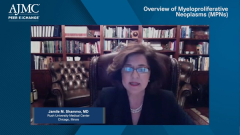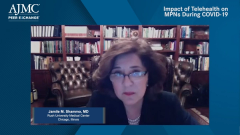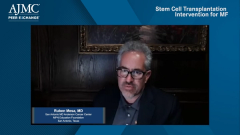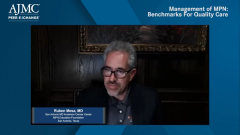
Overview of Myeloproliferative Neoplasms (MPNs)
Jamile Shammo, MD, reviews the various types of MPNs [myeloproliferative neoplasms] and how they differ from MDS [myelodysplastic syndrome].
Episodes in this series

Bruce Feinberg, DO: Hello, and welcome to this AJMC®program titled, “Exploring the Implementation of Quality Care Programs for Patients With Myeloproliferative Neoplasms.” I’m Dr Bruce Feinberg, vice president [VP] of clinical affairs and chief medical officer at Cardinal Health Specialty Solutions in Atlanta, Georgia. Joining me in this discussion are my colleagues Kathy Oubre, chief operations officer at Pontchartrain Cancer Center in Hammond, Louisiana; Michael Reff, the executive director and founder of National Community Oncology Dispensing Association in Cazenovia, New York; Dr Jamile Shammo from Rush University Medical Center in Chicago, Illinois; and Dr Ruben Mesa, director of The University of Texas Health San Antonio MD Anderson Cancer Center and director/VP of MPN Education Foundation in San Antonio, Texas. It is great to have you all.
We will be referring to one another by first names to keep it collegial, and we are going to get started with our panel in just a moment. We hope to provide you with an overview of MPNs [myeloproliferative neoplasms], so we will highlight the incorporation of quality-care programing for improved disease management and patient care.
In this first segment, we are going to touch on topics that are going to be foundational, and that is an overview of myeloproliferative neoplasms. Depending on your familiarity and your age, you might not have known these were neoplasms. You might have called them myeloproliferative disorders if you go back far enough. You may know that there are individual diseases that do not sound related by their names, yet they are. There are diseases you may have thought were related that are no longer part of the classification, so this notion of MPNs is worth a bit just to level set them.
To do that, I will ask Dr Shammo exactly what they are. What differentiates them from chronic leukemias. What differentiates them from myelodysplasia? Is it their abnormal growth? They are proliferative, yet they are not those; they are something else, yet they are still hematologic neoplasms. Let’s start by understanding what they are and what makes them different.
Jamile M. Shammo, MD: I am glad to hear you say that because the phrase myeloproliferative neoplasms has been applied since 2008 to reflect the clonal nature of those disorders, which had been previously referred to as myeloproliferative disorders, as you have said previously. The reason for that is precisely the identification of the JAK2 mutation. This was the first inclination that those disorders seemingly represent a clonal population of disorders with clonal meaning neoplastic. They share common features, which are chronic clonal proliferations of the stem cells that lead to uncontrolled myeloid growth of various blood elements. This is driven by various driver mutations that have been identified over the years, with the first being the JAK2 mutation.
The phenotype of those disorders is determined by the driver mutation that drives that phenotype. Of course, the 3 most common are typically polycythemia vera [PV], essential thrombocythemia [ET], and myelofibrosis [MF]. I have to say that MPNs also encompass chronic myelogenous leukemia, but this tends to be Philadelphia chromosome positive [Ph+]. The MPNs are broadly divided by the presence or absence of the Philadelphia chromosome, so once you rule that out, then you are talking about the classically Philadelphia chromosome negative [Ph-] MPNs. ET, PV, and myelofibrosis represent the most common groups.
Bruce Feinberg, DO: For the purposes of the ongoing conversation, we are going to talk about 3 diseases: ET, PV, and MF. We will talk about them to some degree individually, and we will talk about them under the umbrella because there is overlap in terms of things like molecular-driver mutations, etc.
Jamile M. Shammo, MD: Correct. You had asked about some of the differences between MPNs and MDS [myelodysplastic syndromes]. Granted, with myelodysplastic syndromes, you must demonstrate the presence of dysplasia in the bone marrow biopsy. That is the hallmark of MDS. Of course, there is something called overlap syndrome in which you see dysplasia and myeloproliferation. This is the MDS/MPN overlap syndrome. You can think of all the myeloid disorders as some kind of a spectrum of disorders with MDS on 1 end and MPN on the other with MDS/MPN somewhere in between.
Transcript edited for clarity.
Newsletter
Stay ahead of policy, cost, and value—subscribe to AJMC for expert insights at the intersection of clinical care and health economics.













































































